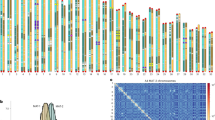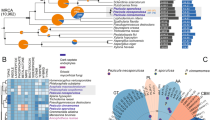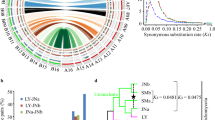Abstract
Sexual reproduction is ubiquitous among eukaryotes, and fully asexual lineages are extremely rare. Prominent among ancient asexual lineages are the arbuscular mycorrhizal fungi (AMF), a group of plant symbionts with a multinucleate cytoplasm. Genomic divergence among co-existing nuclei was proposed to drive the evolutionary success of AMF in the absence of sex1, but this hypothesis has been contradicted by recent genome analyses that failed to find significant genetic diversity within an AMF isolate2,3. Here, we set out to resolve issues surrounding the genome organization and sexual potential of AMF by exploring the genomes of five isolates of Rhizophagus irregularis, a model AMF. We find that genetic diversity in this species varies among isolates and is structured in a homo-dikaryon-like manner usually linked with the existence of a sexual life cycle. We also identify a putative AMF mating-type locus, containing two genes with structural and evolutionary similarities with the mating-type locus of some Dikarya. Our analyses suggest that this locus may be multi-allelic and that AMF could be heterothallic and bipolar. These findings reconcile opposing views on the genome organization of these ubiquitous plant symbionts and open avenues for strain improvement and environmental application of these organisms.
This is a preview of subscription content, access via your institution
Access options
Subscribe to this journal
Receive 12 digital issues and online access to articles
$119.00 per year
only $9.92 per issue
Buy this article
- Purchase on Springer Link
- Instant access to full article PDF
Prices may be subject to local taxes which are calculated during checkout




Similar content being viewed by others
References
Kuhn, G., Hijri, M. & Sanders, I. R. Evidence for the evolution of multiple genomes in arbuscular mycorrhizal fungi. Nature 414, 742–745 (2001).
Tisserant, E. et al. Genome of an arbuscular mycorrhizal fungus provides insight into the oldest plant symbiosis. Proc. Natl Acad. Sci. USA 110, 20117–20122 (2013).
Lin, K. et al. Single nucleus genome sequencing reveals high similarity among nuclei of an endomycorrhizal fungus. PLoS Genet. 10, e1004078 (2014).
Lehtonen, J., Jennions, M. D. & Kokko, H. The many costs of sex. Trends Ecol. Evol. 27, 172–178 (2012).
Goddard, M. R., Godfray, H. C. J. & Burt, A. Sex increases the efficacy of natural selection in experimental yeast populations. Nature 434, 636–640 (2005).
Butlin, R. The costs and benefits of sex: new insights from old asexual lineages. Nature Rev. Genet. 3, 311–317 (2002).
Fitter, A. H. & Moyersoen, B. Evolutionary trends in root–microbe symbioses. Phil. Trans. R. Soc. Lond. B 351, 1367–1375 (1996).
Heckman, D. S. et al. Molecular evidence for the early colonization of land by fungi and plants. Science 293, 1129–1133 (2001).
Young, J. P. W. Genome diversity in arbuscular mycorrhizal fungi. Curr. Opin. Plant Biol. 26, 113–119 (2015).
Boon, E., Halary, S., Bapteste, E. & Hijri, M. Studying genome heterogeneity within the arbuscular mycorrhizal fungal cytoplasm. Genome Biol. Evol. 7, 505–521 (2015).
Croll, D., Corradi, N., Gamper, H. A. & Sanders, I. R. Multilocus genotyping of arbuscular mycorrhizal fungi and marker suitability for population genetics. New Phytol. 180, 564–568 (2008).
Ehinger, M., Koch, A. M. & Sanders, I. R. Changes in arbuscular mycorrhizal fungal phenotypes and genotypes in response to plant species identity and phosphorus concentration. New Phytol. 184, 412–423 (2009).
Ropars, J. & Corradi, N. Homokaryotic vs heterokaryotic mycelium in arbuscular mycorrhizal fungi: different techniques, different results? New Phytol. 208, 638–641 (2015).
Sanders, I. R. & Croll, D. Arbuscular mycorrhiza: the challenge to understand the genetics of the fungal partner. Annu. Rev. Genet. 44, 271–292 (2010).
Riley, R. & Corradi, N. Searching for clues of sexual reproduction in the genomes of arbuscular mycorrhizal fungi. Fungal Ecol. 6, 44–49 (2013).
Heitman, J., Kronstad, J. W., Taylor, J. W. & Casselton, L. A. (eds) Sex in Fungi: Molecular Determination and Evolutionary Implications (ASM, 2007).
Casselton, L. A. & Olesnicky, N. S. Molecular genetics of mating recognition in basidiomycete fungi. Microbiol. Mol. Biol. Rev. 62, 55–70 (1998).
Coppin, E., Debuchy, R., Arnaise, S. & Picard, M. Mating types and sexual development in filamentous ascomycetes. Microbiol. Mol. Biol. Rev. 61, 411–428 (1997).
Cisar, C. R. & TeBeest, D. O. Mating system of the filamentous ascomycete, Glomerella cingulata. Curr. Genet. 35, 127–133 (1999).
Cantu, D. et al. Genome analyses of the wheat yellow (stripe) rust pathogen Puccinia striiformis f. sp. tritici reveal polymorphic and haustorial expressed secreted proteins as candidate effectors. BMC Genomics 14, 270 (2013).
Sędzielewska, K. A. et al. Estimation of the Glomus intraradices nuclear DNA content. New Phytol. 192, 794–797 (2011).
Banham, A. H. et al. An N-terminal dimerization domain permits homeodomain proteins to choose compatible partners and initiate sexual development in the mushroom Coprinus cinereus. Plant Cell 7, 773–783 (1995).
Kosugi, S., Hasebe, M., Tomita, M. & Yanagawa, H. Systematic identification of cell cycle-dependent yeast nucleocytoplasmic shuttling proteins by prediction of composite motifs. Proc. Natl Acad. Sci. USA 106, 10171–10176 (2009).
Halary, S. et al. Mating type gene homologues and putative sex pheromone-sensing pathway in arbuscular mycorrhizal fungi, a presumably asexual plant root symbiont. PLoS ONE 8, e80729 (2013).
Sokolski, S., Dalpé, Y. & Piché, Y. Phosphate transporter genes as reliable gene markers for the identification and discrimination of arbuscular mycorrhizal fungi in the genus Glomus. Appl. Environ. Microbiol. 77, 1888–1891 (2011).
Corradi, N. & Sanders, I. R. Evolution of the P-type II ATPase gene family in the fungi and presence of structural genomic changes among isolates of Glomus intraradices. BMC Evol. Biol. 6, 21 (2006).
Corradi, N. et al. High-level molecular diversity of copper–zinc superoxide dismutase genes among and within species of arbuscular mycorrhizal fungi. Appl. Environ. Microbiol. 75, 1970–1978 (2009).
Corradi, N., Hijri, M., Fumagalli, L. & Sanders, I. R. Arbuscular mycorrhizal fungi (Glomeromycota) harbour ancient fungal tubulin genes that resemble those of the chytrids (Chytridiomycota). Fungal Genet. Biol. 41, 1037–1045 (2004).
Devier, B., Aguileta, G., Hood, M. E. & Giraud, T. Ancient trans-specific polymorphism at pheromone receptor genes in basidiomycetes. Genetics 181, 209–223 (2008).
Anderson, J. B. & Kohn, L. M. in Sex in Fungi: Molecular Determination and Evolutionary Implications (eds Heitman, J., Kronstad, J. W., Taylor, J. W. & Casselton, L. A. ) 333–348 (ASM, 2007).
Jansa, J., Mozafar, A., Banke, S., McDonald, B. A. & Frossard, E. Intra- and intersporal diversity of ITS rDNA sequences in Glomus intraradices assessed by cloning and sequencing, and by SSCP analysis. Mycol. Res. 106, 670–681 (2002).
Bankevich, A. et al. SPAdes: a new genome assembly algorithm and its applications to single-cell sequencing. J. Comput. Biol. 19, 455–477 (2012).
Boetzer, M., Henkel, C. V., Jansen, H. J., Butler, D. & Pirovano, W. Scaffolding pre-assembled contigs using SSPACE. Bioinformatics 27, 578–579 (2011).
Chikhi, R. & Medvedev, P. Informed and automated k-mer size selection for genome assembly. Bioinformatics 30, 31–37 (2014).
Simão, F. A., Waterhouse, R. M., Ioannidis, P., Kriventseva, E. V. & Zdobnov, E. M. BUSCO: assessing genome assembly and annotation completeness with single-copy orthologs. Bioinformatics 31, 3210–3212 (2015).
Zerbino, D. R. Using the Velvet de novo assembler for short-read sequencing technologies. Curr. Protoc. Bioinformatics 31, 11.5.1–11.5.12 (2010).
Boisvert, S., Laviolette, F. & Corbeil, J. Ray: simultaneous assembly of reads from a mix of high-throughput sequencing technologies. J. Comput. Biol. 17, 1519–1533 (2010).
Darling, A. C. E., Mau, B., Blattner, F. R. & Perna, N. T. Mauve: multiple alignment of conserved genomic sequence with rearrangements. Genome Res. 14, 1394–1403 (2004).
Beaudet, D. et al. Intraisolate mitochondrial genetic polymorphism and gene variants coexpression in arbuscular mycorrhizal fungi. Genome Biol. Evol. 7, 218–227 (2015).
Lee, J. & Young, J. P. W. The mitochondrial genome sequence of the arbuscular mycorrhizal fungus Glomus intraradices isolate 494 and implications for the phylogenetic placement of Glomus. New Phytol. 183, 200–211 (2009).
Rutherford, K. et al. Artemis: sequence visualization and annotation. Bioinformatics 16, 944–945 (2000).
Li, H. & Durbin, R. Fast and accurate short read alignment with Burrows–Wheeler transform. Bioinformatics 25, 1754–1760 (2009).
Li, H. A statistical framework for SNP calling, mutation discovery, association mapping and population genetical parameter estimation from sequencing data. Bioinformatics 27, 2987–2993 (2011).
Garrison, E. & Marth, G. Haplotype-based variant detection from short-read sequencing. Preprint at http://arxiv.org/abs/1207.3907 (2012).
R Development Core Team. R: A Language and Environment for Statistical Computing (R Foundation for Statistical Computing) (2008); http://www.R-project.org
Kofler, R. et al. PoPoolation: a toolbox for population genetic analysis of next generation sequencing data from pooled individuals. PLoS ONE 6, e15925 (2011).
McKenna, A. et al. The Genome Analysis Toolkit: a MapReduce framework for analyzing next-generation DNA sequencing data. Genome Res. 20, 1297–1303 (2010).
Dong, C. & Yu, B. Mutation surveyor: an in silico tool for sequencing analysis. Methods Mol. Biol. 760, 223–237 (2011).
Bennett, M. D., Leitch, I. J., Price, H. J. & Johnston, J. S. Comparisons with caenorhabditis (approximately 100 Mb) and drosophila (approximately 175 Mb) using flow cytometry show genome size in arabidopsis to be approximately 157 Mb and thus approximately 25% larger than the Arabidopsis genome initiative estimate of approximately 125 Mb. Ann. Bot. 91, 547–557 (2003).
Schindelin, J. et al. Fiji: an open-source platform for biological-image analysis. Nature Methods 9, 676–682 (2012).
Stanke, M. & Morgenstern, B. AUGUSTUS: a web server for gene prediction in eukaryotes that allows user-defined constraints. Nucleic Acids Res. 33, W465–W467 (2005).
Finn, R. D. et al. Pfam: the protein families database. Nucleic Acids Res. 42, D222–D230 (2014).
Gough, J., Karplus, K., Hughey, R. & Chothia, C. Assignment of homology to genome sequences using a library of hidden Markov models that represent all proteins of known structure. J. Mol. Biol. 313, 903–919 (2001).
Lupas, A., Van Dyke, M. & Stock, J. Predicting coiled coils from protein sequences. Science 252, 1162–1164 (1991).
Noé, L. & Kucherov, G. YASS: enhancing the sensitivity of DNA similarity search. Nucleic Acids Res. 33, W540–W543 (2005).
Robinson, J. T. et al. Integrative genomics viewer. Nature Biotechnol. 29, 24–26 (2011).
Dreissig, S. et al. Measuring meiotic crossovers via multi-locus genotyping of single pollen grains in barley. PLoS ONE 10, e0137677 (2015).
de Bourcy, C. F. A. et al. A quantitative comparison of single-cell whole genome amplification methods. PLoS ONE 9, e105585 (2014).
Thompson, J. D., Higgins, D. G. & Gibson, T. J. CLUSTAL W: improving the sensitivity of progressive multiple sequence alignment through sequence weighting, position-specific gap penalties and weight matrix choice. Nucleic Acids Res. 22, 4673–4680 (1994).
Guindon, S. et al. New algorithms and methods to estimate maximum-likelihood phylogenies: assessing the performance of PhyML 3.0. Syst. Biol. 59, 307–321 (2010).
Darriba, D., Taboada, G. L., Doallo, R. & Posada, D. jModelTest 2: more models, new heuristics and parallel computing. Nature Methods 9, 772–772 (2012).
Guindon, S. & Gascuel, O. A simple, fast, and accurate algorithm to estimate large phylogenies by maximum likelihood. Syst. Biol. 52, 696–704 (2003).
Suyama, M., Torrents, D. & Bork, P. PAL2NAL: robust conversion of protein sequence alignments into the corresponding codon alignments. Nucleic Acids Res. 34, W609–W612 (2006).
Paradis, E., Claude, J. & Strimmer, K. APE: analyses of phylogenetics and evolution in R language. Bioinformatics 20, 289–290 (2004).
Charif, D. & Lobry, J. R. in Structural Approaches to Sequence Evolution (eds Bastolla, D. U., Porto, P. D. M., Roman, D. H. E. & Vendruscolo, D. M. ) 207–232 (Springer, 2007).
Li, W. H. Unbiased estimation of the rates of synonymous and nonsynonymous substitution. J. Mol. Evol. 36, 96–99 (1993).
Rozas, J. & Rozas, R. DnaSP, DNA sequence polymorphism: an interactive program for estimating population genetics parameters from DNA sequence data. Comput. Appl. Biosci. 11, 621–625 (1995).
Acknowledgements
The authors thank J.W. Taylor, T. James, D. Beaudet, T. Giraud, M. Lόpez-Villavicencio and I. de la Providencia, for constructive comments and suggestions on previous versions of this manuscript. The authors also thank I. Sanders (University of Lausanne) and Y. Dalpé (Agriculture Canada, Ottawa) for providing the in vitro isolates of Rhizophagus irregularis used in this study, M. Griesmann (Faculty of Biology, LMU Munich) for help with the BUSCO analyses and S. Dreissig (IPK, Gatersleben) for help with WGA work. N.C. is a fellow of the Canadian Institute for Advanced Research. N.C.'s work is supported by the Discovery programme from the Natural Sciences and Engineering Research Council of Canada (NSERC-Discovery), an Early Researcher Award from the Ontario Ministry of Research and Innovation (ER13-09-190) and the ZygoLife project funded by the National Science Foundation (DEB 1441677). M.K. was financed by the European Social Fund (ESF) and the state budget of Czech Republic through the Operational Programme Education for Competitiveness (OPEC) under project number CZ.1.07/2.3.00/30.0048.
Author information
Authors and Affiliations
Contributions
J.R., K.S.T., A.B. and N.C. planned the experiments. J.R., K.S.T., J.N., P.C., L.F., T.M., M.K. and J.F. performed experiments. J.R., A.P., A.B. and N.C. performed bioinformatic analyses. J.R. and N.C. drafted the manuscript with contributions from K.S.T. and A.B.
Corresponding author
Ethics declarations
Competing interests
The authors declare no competing financial interests.
Supplementary information
Supplementary Information
Supplementary Figures 1-10, Tables 1-4 and 7 (PDF 21415 kb)
Supplementary Table 5
Supplementary Table 5 (XLSX 18 kb)
Supplementary Table 6
Supplementary Table 6 (XLSX 44 kb)
Rights and permissions
About this article
Cite this article
Ropars, J., Toro, K., Noel, J. et al. Evidence for the sexual origin of heterokaryosis in arbuscular mycorrhizal fungi. Nat Microbiol 1, 16033 (2016). https://doi.org/10.1038/nmicrobiol.2016.33
Received:
Accepted:
Published:
DOI: https://doi.org/10.1038/nmicrobiol.2016.33
This article is cited by
-
Stochastic nuclear organization and host-dependent allele contribution in Rhizophagus irregularis
BMC Genomics (2023)
-
Arbuscular mycorrhizal fungi heterokaryons have two nuclear populations with distinct roles in host–plant interactions
Nature Microbiology (2023)
-
Comparative RNA sequencing-based transcriptome profiling of ten grapevine rootstocks: shared and specific sets of genes respond to mycorrhizal symbiosis
Mycorrhiza (2023)
-
Mycorrhizal response of Solanum tuberosum to homokaryotic versus dikaryotic arbuscular mycorrhizal fungi
Mycorrhiza (2023)
-
Rhizophagus proliferus genome sequence reiterates conservation of genetic traits in AM fungi, but predicts higher saprotrophic activity
Archives of Microbiology (2022)



